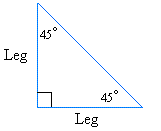

Quite frequently on the GMAT, you will find yourself in a situation in which you know that a particular triangle is a right triangle, and you will know the lengths of two of the three sides. For example, on a typical GMAT question you might use the Pythagorean Theorem to determine the base and height of a triangle and then ultimately find its area. Nevertheless, it’s important to recognize that both formulas refer to the same sides.

The sides that we referred to as b and h above are now labeled as b and a, since the custom when using the Pythagorean Theorem is to employ the variables a, b, and c. The Pythagorean Theorem states that, in a right triangle, the square of the length of the hypotenuse is equal to the sum of the squares of the lengths of the other two sides. The area of the rectangle is ( b)( h), so either one of the congruent right triangles forming it has an area equal to half of that rectangle. This is intuitively logical because another congruent right triangle can be placed against it so that the hypotenuses are the same line segment, forming a rectangle with sides having length b and width h. If the lengths of both the legs are known, then by setting one of these sides as the base b and the other as the height h, the area of the right triangle is easy to calculate using the standard formula for a triangle’s area: The legs (or their lengths) are usually labeled a and b.Įither of the legs can be considered a base and the other leg would be considered the height (or altitude), because the right angle automatically makes them perpendicular. When using the Pythagorean Theorem, the hypotenuse or its length is often labeled with a lower case c. The sides adjacent to the right angle are the legs. The side opposite the right angle is called the hypotenuse. Since the three interior angles of a triangle add up to 180 degrees, in a right triangle, since one angle is always 90 degrees, the other two must always add up to 90 degrees (they are complementary). Right triangles are triangles in which one of the interior angles is 90 degrees, a right angle.


 0 kommentar(er)
0 kommentar(er)
